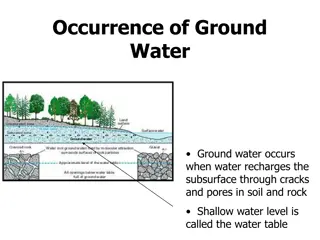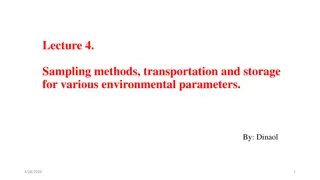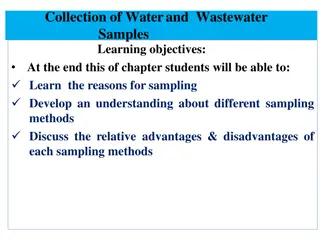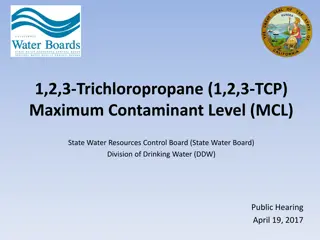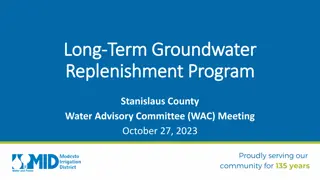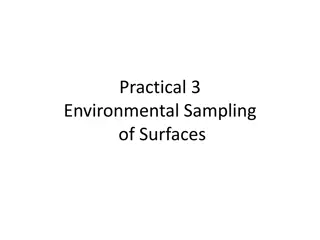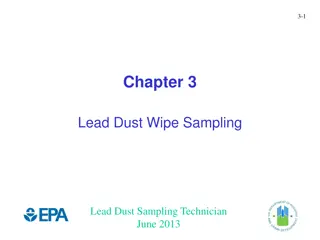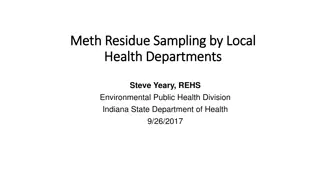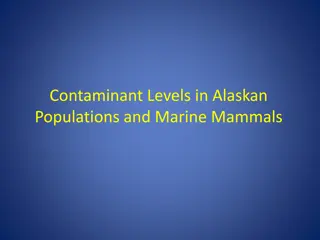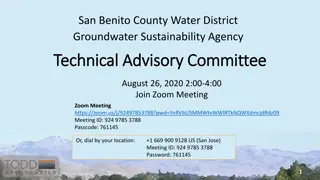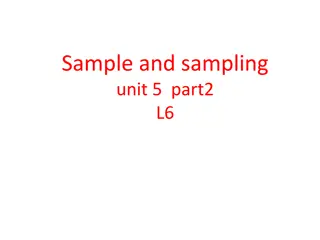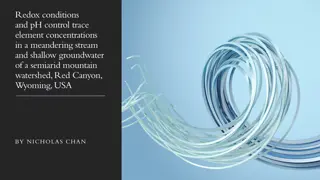Groundwater Contaminant Identification Through Water Sampling Techniques
This informative content discusses water sampling techniques used to identify contaminants in groundwater, focusing on factors such as FSMA regulations, total nitrogen levels, and best practices for sampling. It also addresses the importance of monitoring agricultural water quality to prevent microbial contamination of produce, highlighting methods like Method 1603 and Method 1103. The Food Safety Modernization Act (FSMA) guidelines set criteria based on E. coli presence to ensure safe water usage in agriculture. Compliance dates for agricultural water regulations and the significance of immediate corrective actions upon contamination detection are emphasized.
- Groundwater Contaminants
- Water Sampling Techniques
- FSMA Regulations
- Agricultural Water Quality
- Microbial Contamination
Download Presentation

Please find below an Image/Link to download the presentation.
The content on the website is provided AS IS for your information and personal use only. It may not be sold, licensed, or shared on other websites without obtaining consent from the author. Download presentation by click this link. If you encounter any issues during the download, it is possible that the publisher has removed the file from their server.
E N D
Presentation Transcript
Water Sampling Techniques to Identify Ground Water Contaminants Corin Slown and David Holland
Overview Introductions FSMA regulations and new requirements Ag Waiver and Total Nitrogen Ground water contaminants Best practices for sampling Questions
Agricultural water can be a major conduit of pathogens that can contaminate produce FSMA s produce safety rule sets microbial quality standards for agricultural water, including irrigation water that comes into contact with produce If finalized, the new agricultural water compliance dates would begin January 26, 2022, for the largest farms. Small farms and very small farms would have until January 26, 2023, and January 26, 2024, respectively. https://www.fda.gov/Food/GuidanceRegulation/FSMA/ucm334114.htm
Food Safety Modernization Act (FSMA) EQUIVALENT TESTING METHODOLOGY FOR AGRICULTURAL WATER 1. Method 1603: Escherichia coli (E. coli) in Water by Membrane Filtration Using Modified membrane-Thermotolerant Escherichia coli Agar (Modified mTEC) (September 2014). U.S. Environmental Protection Agency. EPA-821-R-14-010. 2. Method 1103.1: Escherichia coli (E. coli) in Water by Membrane Filtration Using membrane-Thermotolerant Escherichia coli Agar (mTEC) (March 2010). U.S. Environmental Protection Agency. EPA-821-R-10-002. 3. Method 1604: Total Coliforms and Escherichia coli in Water by Membrane Filtration Using a Simultaneous Detection Technique (MI Medium) (September 2002). U.S. Environmental Protection Agency. EPA-821-R-02-024.
FSMA The final rule establishes two sets of criteria for microbial water quality, both of which are based on the presence of generic E. coli, which can indicate the presence of fecal contamination. No detectable generic E. coli are allowed for certain uses of agricultural water in which it is reasonably likely that potentially dangerous microbes, if present, would be transferred to produce through direct or indirect contact. Examples include water used for washing hands during and after harvest, water used on food-contact surfaces, water used to directly contact produce (including to make ice) during or after harvest, and water used for sprout irrigation. The rule establishes that such water use must be immediately discontinued and corrective actions taken before re-use for any of these purposes if generic E. coli is detected. The rule prohibits use of untreated surface water for any of these purposes.
FSMA The final rule establishes two sets of criteria for microbial water quality, both of which are based on the presence of generic E. coli, which can indicate the presence of fecal contamination. The second set of numerical criteria is for agricultural water that is directly applied to growing produce (other than sprouts). The criteria are based on two values, the geometric mean (GM) and the statistical threshold (STV). The GM of samples is 126 or less CFU of generic E. coli per 100 mL of water and the STV of samples is 410 CFU or less of generic E. coli in 100 mL of water. The GM is an average, and therefore represents what is called the central tendency of the water quality (essentially, the average amount of generic E. coli in a water source). STV reflects the amount of variability in the water quality (indicating E. coli levels when adverse conditions come into play like rainfall or a high river stage that can wash waste into rivers and canals). This is ~ as the level at which 90 percent of the samples are below the value.
Testing The final rule adopts the general approach to testing untreated water used for certain purposes. The rule still bases testing frequency on the type of water source (i.e. surface or ground water). In testing untreated surface water considered the most vulnerable to external influences that is directly applied to growing produce (other than sprouts), the FDA requires farms to do an initial survey, using a minimum of 20 samples, collected as close as is practicable to harvest over the course of two to four years. The initial survey findings are used to calculate the GM and STV (these two figures are referred to as the microbial water quality profile ) and determine if the water meets the required microbial quality criteria. After the initial survey has been conducted, an annual survey of a minimum of five samples per year is required to update the calculations of GM and STV. The five new samples, plus the previous most recent 15 samples, create a rolling dataset of 20 samples for use in confirming that that the water is still used appropriately by recalculating the GM and STV.
Testing For untreated ground water that is directly applied to growing produce (other than sprouts), the FDA requires farms to do an initial survey, using a minimum of four samples, collected as close as is practicable to harvest, during the growing season or over a period of one year. The initial survey findings are used to calculate the GM and STV and determine if the water meets the required microbial quality criteria. After the initial survey has been conducted, an annual survey of a minimum of one sample per year is required to update the calculations of GM and STV. The new sample, plus the previous most recent three samples, create a rolling dataset of four samples for use in confirming that that the water is still used appropriately by recalculating the GM and STV.
Testing For untreated ground water that is used for the purposes for which no detectable generic E. coli is allowed, the FDA requires farms to initially test the untreated ground water at least four times during the growing season or over a period of one year. Farms must determine whether the water can be used for that purpose based on these results. If the four initial sample results meet the no detectable generic E. coli criterion, testing can be done once annually thereafter, using a minimum of one sample. Farms must resume testing at least four times per growing season or year if any annual test fails to meet the microbial quality criterion.
Exemptions The rule does not apply to: Produce that is not a raw agricultural commodity (RAC). A raw agricultural commodity is any food in its raw or natural state. The following produce commodities that FDA has identified as rarely consumed raw: asparagus; black beans, great Northern beans, kidney beans, lima beans, navy beans, and pinto beans; garden beets (roots and tops) and sugar beets; cashews; sour cherries; chickpeas; cocoa beans; coffee beans; collards; sweet corn; cranberries; dates; dill (seeds and weed); eggplants; figs; horseradish; hazelnuts; lentils; okra; peanuts; pecans; peppermint; potatoes; pumpkins; winter squash; sweet potatoes; and water chestnuts Food grains, including barley, dent- or flint-corn, sorghum, oats, rice, rye, wheat, amaranth, quinoa, buckwheat, and oilseeds (e.g. cotton seed, flax seed, rapeseed, soybean, and sunflower seed) Produce that is used for personal or on-farm consumption Farms that have an average annual value of produce sold during the previous three-year period of $25,000 or less The rule provides an exemption for produce that receives commercial processing that adequately reduces the presence of microorganisms of public health significance, under certain conditions. The rule also provides a qualified exemption and modified requirements for certain farms.
Produce Safety Rule Audits USDA Harmonized GAP checklist GlobalG.A.P. Sustainable Water checklist SQF subpart E Agricultural Water
The Water System Produce Safety Rule Requirements Inspection of all agricultural water systems at start of agricultural season and on an annual basis
Field Packed Commodities Microbial water testing must occur during the production and harvest season. The frequency of testing and point of water sampling shall be determined based on the risk assessment and current industry standards for commodities being grown (Testing must have occurred at a minimum within the last 12 months). The type of test and acceptance criteria must also be determined based on the risk assessment but should include microbial pathogens of concern and standard indicators of fecal contamination (generic E. coli and/or fecal coliforms). If all agricultural water is from a municipal source, the testing must be done at the source where the water is used.
Irrigated Lands Regulatory Program Overview The Central Coast Water Board regulates discharges from irrigated agricultural lands to protect surface water and groundwater, using a permit called a Conditional Waiver of Waste Discharge Requirements that applies to owners and operators of irrigated land used for commercial crop production. Focusing on priority water quality issues, such as pesticides and toxicity, nutrients, and sediments especially nitrate impacts to drinking water sources. Priority: major agricultural areas of the region - the Salinas River, Santa Maria, and Pajaro River watersheds. Irrigated Lands Regulatory Program Operational Measures Irrigated Lands Regulatory Program Contacts State Water Board's Agriculture - Irrigated Lands Regulatory Program Website
Ag Order 4.0 Coming Soon Ag Order 3.0 required groundwater monitoring in 2017 and also expands the Total Nitrogen Applied reporting requirement. Growers must sample: 1) primary irrigation well located on each ranch, and 2) all domestic wells located on the assessor parcel numbers where the ranch is located during two rounds of sampling Groundwater samples must be collected by a qualified third party, such as a consultant, technician or person conducting cooperative monitoring on behalf of the grower Laboratory analysis must be conducted by a State certified laboratory that can coordinate with the grower to submit the sampling results electronically using the Water Board s GeoTracker electronic deliverable format (known as EDF).
Total Nitrogen Reporting The Total Nitrogen Applied reporting requirement includes all Tier 2 and Tier 3 ranches that grow any crop with a high potential of loading nitrogen to groundwater. These high risk crops include the following: beet, broccoli, cabbage, cauliflower, celery, Chinese cabbage (Napa), collard, endive, kale, leek, lettuce (leaf and head), mustard, onion (dry and green), spinach, strawberry, pepper (fruiting), and parsley. If any of these crops are grown on your ranch, then a Total Nitrogen Applied report is required for all crops grown on the ranch. The first Total Nitrogen Applied report for Ag Order 3.0 was due on March 1, 2018. Track all nitrogen applied from fertilizers, compost, and other materials to each crop; track the total volume of irrigation water applied to the ranch; sample your irrigation water for nitrate; and sample your soil for nitrogen
Why does how you sample matter? Water quality data are only as good as the water samples from which the measurements are made. Even the most precise laboratory analysis of a water sample cannot compensate for improper or poorly executed sampling procedures or for physical and chemical alteration of a sample due to inappropriate sample collection, transport, or storage. THOMAS HARTER, UC Cooperative Extension Hydrogeology Specialist, University of California, Davis, Kearney Agricultural Center, Farm Water Quality Planning (FWQP) series Ground Water Sampling and Monitoring
How frequently should you sample? How often you should sample depends on the purpose of the sampling and the depth of the aquifer formations from which the well draws water.
Equipment pumping or bailing equipment water level meter water quality measuring equipment (These may include probes and instruments for measuring temperature, pH, electric conductivity, dissolved oxygen, reduction-oxidation potential, etc. Inexpensive meters or test kits are available from hardware and pet supply stores.) sample bottles The bottle should be emptied of the original water and dried. For containers for bacteriological samples, consult an analytical laboratory.) field sampling labels and forms preserving containers (coolers, ice, proper chemicals and tools for field preservation per laboratory instructions)
Six Steps to Sampling 1. Sampling Preparations 2. Accessing the Well 3. Measuring the Water Level 4. Purging the Well 5. Collecting the Sample 6. Preserving the Sample
Sources of Groundwater Contamination Storage Tanks Septic Systems Uncontrolled Hazardous Waste Landfills Applied Chemicals Atmospheric Contaminants Surface Impoundments
Contaminant Flow Ground water generally moves slowly, so do contaminants in ground water. Contaminants tend to remain concentrated in the form of a plume that flows along the same path as the ground water. The size and speed of the plume depend on the amount and type of contaminant, its solubility and density, and the velocity of the surrounding ground water.
Ground Water Sampling and Quality Assurance Each sampling event provides a snapshot of water quality. The ground water environment is dynamic. Therefore, the frequency, location, and method of sampling must be well thought out. Well-defined sampling procedures ensure reliable data. Quality Assurance Project Plans described by the Regional Quality Control Board can offer guidance in designing your sampling program.
Sample Collection Protocol A written description of the actual sampling procedures to be used: 1) Determine the type of well construction, i.e. if well is perforated at multiple depths. 2) Determine if the water quality will change with pumping time. This can be based on changes in: a) water level; b) conductivity; or c) water chemistry. 1) Determine the volume of water in the well and the rate of flow in order to calculate necessary purge volumes (usually 3-5) prior to collection.
Other Resources http://www.ccamp.org/ccamp/Reports.html#AgReports https://producesafetyalliance.cornell.edu/sites/producesafetyalliance.cornell.edu/fil es/shared/documents/2017%20GM%20STV%20Worksheet%20v1.0.pdf https://www.waterboards.ca.gov/publications_forms/publications/factsheets/docs/r egion_brds.pdf https://www.waterboards.ca.gov/centralcoast/water_issues/programs/ag_waivers/




